by Amy Plano | Jul 9, 2018 | metabolism, weight loss
What is metabolic testing ?
The million dollar question on everyone’s mind, “what is metabolic testing ?” Many people have heard the term but have no clue what to expect from metabolic testing. The goal of this blog is to clarify this information and tell you exactly how to prepare for the testing to ensure the best results.
Trust me – there is absolutely nothing remotely scary about having your metabolism tested. In fact – I can almost guarantee you will be skipping out of my office with the new information in hand like a kid on Christmas day. Now let’s chat about how to prepare for metabolism testing.
First things first, metabolism testing does not hurt. I promise! We don’t draw blood. Also there is NO physical exertion involved. In the past, I have had patients show up in their workout gear thinking they were going to participate in something that might resemble a stress test. This is certainly not the case. So no worries you can leave your running shoes at home!
The device we use to measure your metabolism is called the Bodygem. This device measures your metabolism by capturing the air you breath.
Sounds pretty easy? Well it is.

Three things to do to prepare for the metabolism test:
Come fasted with no caffeine in your system for 4 hours prior to your test. You can drink plenty of water though!
Please don’t exercise within 4 hours of the test.
Arrive not having smoked a cigarette within 4 hours of the test.
Caffeine, exercise, and nicotine all can slightly increase your metabolic rate. Therefore, we do our best to minimize these variables so we can deliver you the most accurate results.
Curious about what other factors might influence your metabolism? Check out last week’s informative blog “RMR Testing 101” on this exact topic.
The actual test
Once you arrive we will get you all set up! You will sit peacefully in a chair with a small mouth tube in your mouth and a cute little nose clip on. The goal of the nose clip is to create a vacuum seal so no air escapes.
I promise, I will not post any Facebook pictures with your sexy nose clip on:)
By measuring both the amount of oxygen you exhale and the amount of carbon dioxide you expire we are able to calculate your metabolism. It’s that simple. This method is called indirect calorimetry and is one of the most accurate ways to measure metabolism. The test itself takes about 10 minutes.
Like I mentioned, the test does not hurt. However, some people find it uncomfortable as you need to breathe through your mouth for the duration of the test.
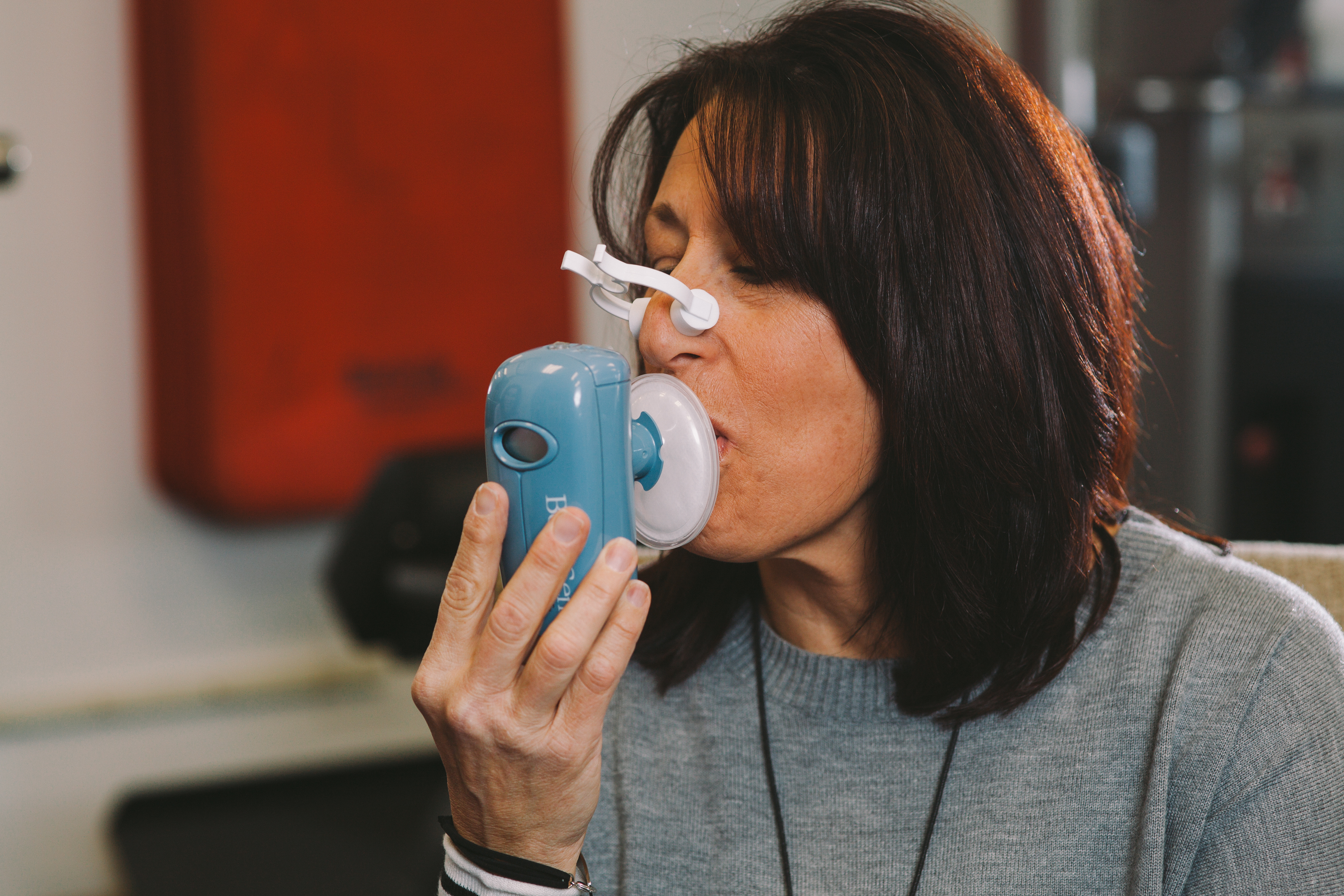
Once the test is complete we need to talk goals. Generally speaking my patients generally have three types of goals – they want to lose weight, maintain their weight or gain weight. Therefore, the next step will be tol weigh you and test your body fat. That way we have a starting point for you to gauge your progress.
Next, we will gather your demographics. Factors such as your age, sex, occupation, type and frequency of exercise, and even your sleep patterns are all important variables in determining an appropriate calorie level for your goals. All this information is then entered into a software program which then generates several important numbers.

The Bodygem tells us the following:
Exactly how many calories you need to take in on the days you workout
Exactly how many calories you need to take in on your non-training (rest) days.
How you compare to other individuals with the same demographics
Your BMI
Once we have this important information we can then specifically tell you where your calories need to be to accomplish your specific goals. We can also make suggestions on your macros if that is something you are interested in. If you need help setting up these numbers in a tracking program like MyfitnessPal we are happy to help guide you as well.
If you need additional services like a customized meal planner with specific meal suggestions or guidance on how to incorporate carbohydrate cycling or intermittent fasting these can all be provided at an additional fee.
The entire metabolic test plus the consult should take no longer than 45 minutes. You will leave with a personalized print out with your results and a solid knowledge of what is metabolic testing really entails. No guesswork involved!
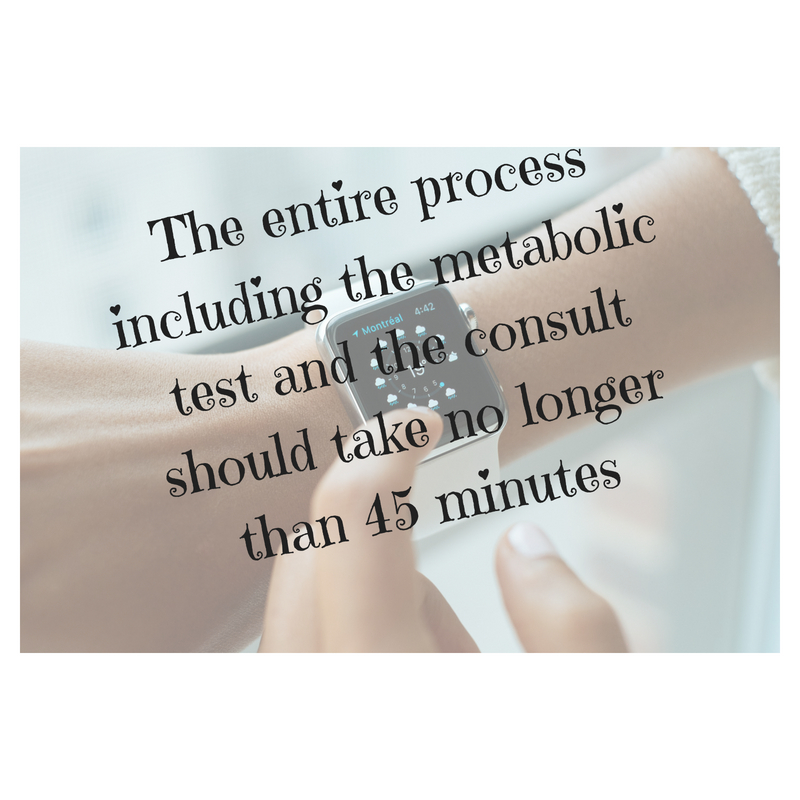
On next week’s blog we will dive deeper into the results. We will interpret the results of three actual Bodygem results and discuss how to apply the information. So now when someone asks you the question, ” what is metabolic testing ” you will be able to give them a A+ answer 🙂
P.S. The icing on the cake is if you purchase the metabolism test during the month of July you will be entitled to a 40 % discount for my birthday. Just use coupon code thisis40 when you schedule your metabolism test on www.amyplano.com to receive the discount. However, act fast as this discount will only be around until July 31, 2018.
Have questions on metabolic testing? Please don’t be shy! Ask in the comments section below.
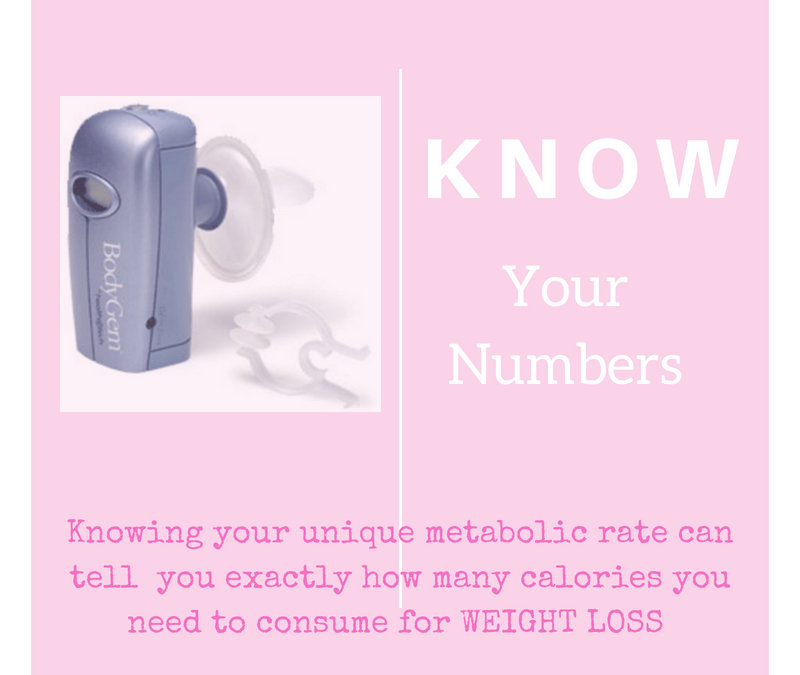
by Amy Plano | Jul 2, 2018 | metabolism, weight loss
Are you unable to lose weight in spite of vigorous exercise and a disciplined training schedule? Are you looking to maximize your performance yet feel like despite all your efforts you are failing miserably? Have you hit a plateau in your weight loss? Would you like to take the “guesswork” out of determining your calories to achieve your goals? Well if you answered “heck yes” to any of the above questions then you are likely the perfect candidate for RMR testing.
What is Metabolism
First things first, before we talk about RMR testing and why it is so friggin’ important we need to define metabolism. Did you know that even when you’re at rest, your body needs energy for its “silent” functions? These include breathing, circulating blood, adjusting hormone levels, and growing and repairing cells. The number of calories your body uses to carry out these basic functions is known as your basal metabolic rate (BMR) or more often referred to outside of a clinical setting as resting metabolic rate (RMR).
There are many factors which determine our metabolism. Some include:
Your body size and composition.
People who are larger or have more muscle burn more calories. Even at rest these folks tend to have higher RMR’s.
Your sex.
Men usually have less body fat and more muscle than do women of the same age and weight. This means men burn more calories at rest (Boo!). But don’t worry, I will be sharing some tips for how us chicks can optimize our metabolisms.
Your age.
As we get older (sigh), the amount of muscle we carry tends to decrease. Fat accounts for more of our weight, slowing down calorie burning. [Tip: If you consistently work out with weights you can help off-set some of this loss 🙂 ]

Two other important factors that determine how many calories your body burns each day:
Food processing (we call this thermogenesis!)
Did you know that digesting, absorbing, transporting and storing the food you consume also expends calories? Score! About 10 percent of the calories you burn each day come from the digestion and absorption of food and nutrients.
Physical activity
Physical activity and exercise accounts for the rest of the calories your body burns up each day. It comes as no surprise that physical activity is by far the most variable of all the factors.

The changes in overall body mass (increase or decrease) ultimately comes down to long-term energy balance which is represented by energy in (via food) and energy out (via metabolic rate). Total energy expenditure is determined by many factors including: body composition, sex, age, thermogenesis and physical activity. Having ‘good’ genetics certainly doesn’t hurt either! So now that you are a master of ‘all terms metabolism’ let’s get down to business.
Here are my top three reasons for why getting your RMR tested is SO important to achieving your body composition and training related goals
1. Takes the guesswork out.
By having your metabolism tested by a professional you never need to ask yourself the annoying questions, “How much or little should I be eating ?!?”
How many times have you entered your height and weight into an online metabolism calculator only to get some crazy number which you have no idea how to interpret?
I cannot tell you how many times patients come into my office following a calorie level that is completely wrong for the goals they are trying to accomplish. This frustrates the heck out of me. It’s not that they are unsuccessful for lack of trying. It’s simply because they have been provided with the wrong information.
By testing your RMR you will now know the exact number of calories your body needs to accomplish your dietary and fitness related goals. There is no more guessing or even second guessing where your calories need to be! Through the use cutting edge technology we can help you determine the exact amount of calories you need to reach your goals. Headache solved!
2. Gives you an accurate baseline.
If you don’t know your baseline calorie needs how do you know if what you are doing is ‘working’?
You have got big goals which I love and admire. However, how can you accomplish your long-term goals if you don’t know where your baseline needs currently are? Testing your metabolism before you make significant changes to your exercise and/or training routine can provide you with a solid foundation in which to make adaptations. Therefore, as things like your body composition, weight and/or performance markers change over time you can adjust your calories relative to your new goals.
Independent of what our specific goals are we all need a caloric starting point. If we don’t have a baseline and we start making changes to our diet how can we tell what specific calorie level is working? Simply put – we can’t.
Therefore, by testing your RMR before making any significant dietary and/ or training changes you are armed with an accurate, reliable calorie level to base your goals on.
3. It helps you when you are stumped.
Knowing your RMR gives you clarity in those moments when no matter how hard you try – you just cannot seem to tackle your dietary and/or fitness goals.
Knowing your your RMR can be critical when you are stumped. As mentioned previously many people base their goals around a calorie level that is not in tune with their goals. Along with the headache this creates can come a massive amount of frustration. Unfortunately, if you have been there you know exactly what I am talking about 🙁
Trying to gain lean muscle mass but struggling like crazy? It could be that your calories are too low. We all know that in order to build anything we need ‘extra’ resources, right? That extra might be money, resources or time. Same goes for putting on muscle. In this case, the extra needs to be in the form of calories. Therefore, for someone aiming to put on muscle they need to FIRST make sure they are taking in enough calories to do.
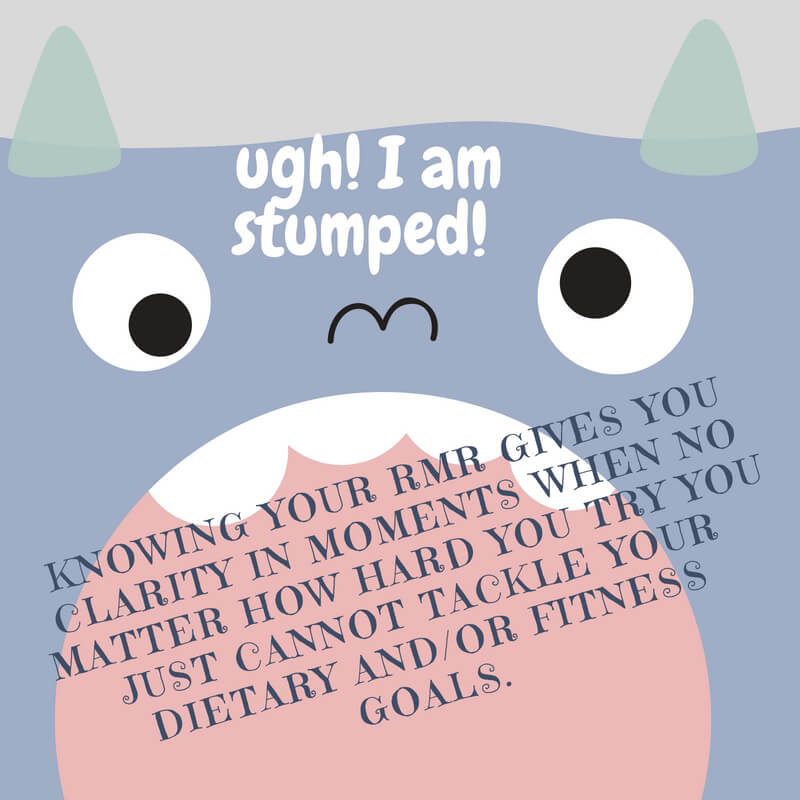
On the flip side, do you feel like you are at a weight loss plateau? Are you meticulously counting calories, carbs, protein and everything under the sun and still not losing weight? Is MyFitnessPal definitely not your pal? For most people the simple answer is their calories are not in tune with their weight loss goals. It could be that their calories are too low. Or it could mean that their calories are too high. How the heck will they know unless they actually test their metabolism?
Knowing your unique RMR for the different ‘seasons’ can help optimize your nutrition during both your off-season and peak training periods. During training, you need to make sure you are taking in enough calories to support not only your training but your ideal body composition for your sport. It’s no surprise when an athlete is not taking in enough calories how quickly they feel the side effects. Unintentional weight can lead to fatigue, burnout and injury. All of these can be factors can be minimized if not avoided entirely.

Leave nothing on the table when it comes to your training. Mama did not raise no fool 🙂
Case in point – I rest my case. Plain and simple – anyone with a performance or body composition related goal should have their metabolism tested. And truth be told I don’t know a whole lot of people who don’t share these goals (especially the later!) By testing your RMR you will no longer be ‘spinning your wheels.’ The precise tools you need to determine the exact calorie level to fit your specific goals is attainable. And just like Jim Rohn’s stated, “When you know what you want and you want it bad enough, you’ll find a way to get it.”
P.S. Did you know we are running a 40 % discount on RMR testing for the month of July? Use the coupon code thisis40 when scheduling your metabolism testing under the ‘appointments’ tab on our website www.amyplano.com
P.P.S. What are you waiting for? This fantastic deal will not be around forever. Cut through all the confusion and get the numbers you need.
P.P.P.S. Does any of this mumbo-jumbo about RMR testing resonate with YOU? If so, in what way? Share your thoughts in the comments below. We ♥ to hear your thoughts. Don’t be shy – we don’t bite.
by Amy Plano | Jun 25, 2018 | metabolism, weight loss
So it is true … this girl right here turns 40 years old on Friday, June 29th. And what better way to celebrate my 40th then with YOU my loyal readers. So how would you like to receive a present from me? How does a 40 % discount on a metabolism test to celebrate this fabulous occasion sound? I don’t know about you but it sounds pretty dang awesome to me.

Heading into the next decade can be a drag. So rather than have a pity party for myself I decided to give you a pretty sweet present to mark this milestone birthday – 40 % off metabolism testing for the whole month of July. Whoot! Whoot!
For the whole month of July redeem coupon code thisis40 when scheduling your metabolism test to receive 40 % off each individual test. The normal rate for a metabolism test is $150.00. Therefore, by redeeming the code thisis40 you save yourself 60 bucks! If that is not pretty sweet – then I don’t know what is.

Important note: In order to receive the most accurate reading on the metabolic test you should be fasted (no food), with no exercise or caffeine within 4 hours of your test time. You can drink plenty of water – just nothing with caffeine or calories.
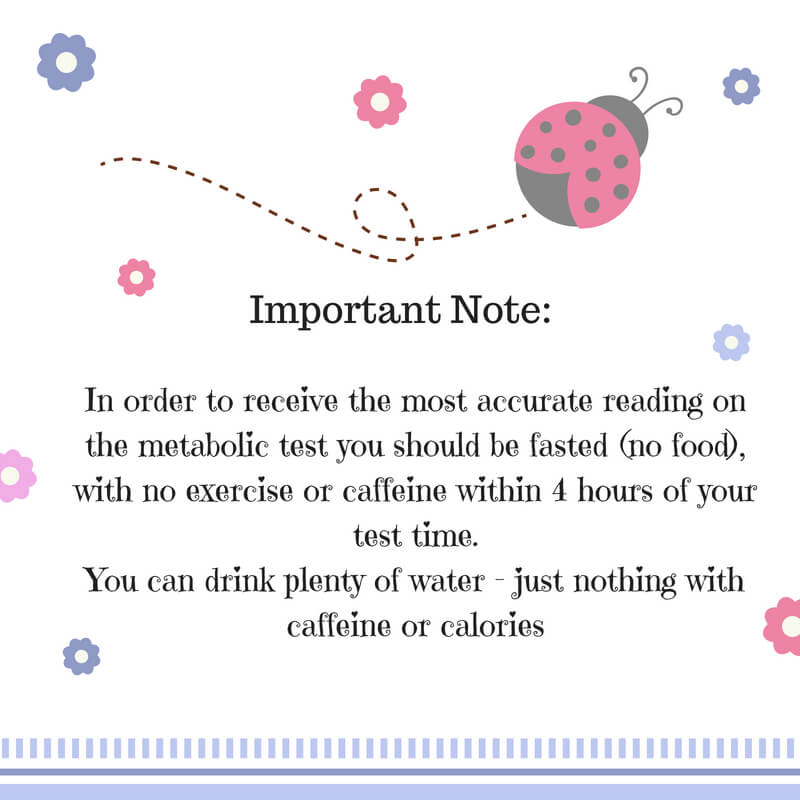
Below are the steps to redeem your discounted metabolism test:
- Click HERE and you will be re-directed to the scheduling section of this website.
- Click the link for “Metabolism Testing” under appointments.
- When the prompts ask you “with” who you would like to schedule you can choose either myself or my fabulous RD Audrey. The discount applies to us BOTH.
- Select the time slot you would like to come in for your metabolism test.
- Next put in your name, phone number and email address.
- Within the information section where it says “Redeem Coupon” put in the discount code thisis40
- Follow the prompts for payment
- Once you have provided payment you will receive an email confirmation with the date and time of your visit.
- Arrive fasted, with no caffeine or exercise within 4 hours of your test.
Our office is located at 500 Boston Post Road, Orange, CT 06477. We are in the same plaza as Hawley Lane Shoes. When you pull into the plaza look for signs for The Plano Program.
Over the next month I will be releasing more information about why having your metabolism tested is SO friggin’ important – so stay tuned for blog updates.
Please fee free to share this birthday gift with anyone who you think might benefit – which I think is pretty much anyone with nutrition related goals. After all who does not want to know their metabolism? Said no one ever 🙂
Have you ever had your metabolism tested? Did you find it helpful in reaching your nutrition related goals. Please tell us your experience in the comments below.
by Amy Plano | Jun 14, 2018 | healthy eating, holiday healthy eating, weight loss, weight loss and alcohol
Between the crazy highs and unseasonably low temperatures this past week in CT (and freakish Tornadoes) it is hard to believe Memorial Day is just around the corner. However, you know it, people will be firing up their grills and breaking out the dogs and burgers. Rather than throwing caution to the wind and deciding you’ll jump on the latest detox diet Tuesday, why not stay ahead of the game? There are plenty of ways to keep your long weekend healthy and tasty!
Sip Responsibly this Memorial Day
Yes – I know this a no brainer! But seriously Memorial Day seems like the official kick off for summer drinking. As if people need a reason to drink, right? However, if you are going to imbibe then why not choose to do so responsibly.
Numero uno – avoid the carb bombs. Margaritas, frozen drinks and unfortunately the likes of craft beers tend to be very calorie and carbohydrate heavy. While Craft beers range in calories most clock in at about 200 – 250 calories per 12-ounce bottle. Thinking about knocking back 2-3? You are looking at an upward of 600 calories in alcohol alone.
Side note – back in the day when I used to bartend I would start my shift by making 5 gallon tubs of margaritas. In each batch I would put two full pounds of quick dissolve sugar! Yes – holy moley is right! Sugar rush for sure.
Instead, opt for clear spirits like vodka, gin, and rum mixed with a no/low-calorie mixer. For example, a Titos and Club Soda will only set you back about 95 calories. Plus did you know flavored vodkas (think Stoli Raspberry, Absolut Melon, Pinnacle Whipped Cream) have the same amount of calories as plain vodka? So you can even get fancy and mix a flavored vodka with a flavored club soda squeeze some lime on top and there you have your new favorite skinny summer cocktail.
Or if hard liquor is not your style – choose a light beer and you are only looking at about 100 calories as well. A glass of white or red wine is about 150 calories. Want to cut those those calories in half? Make yourself a wine spritzer! Fill a wine glass with crushed ice. Then pour 2-3 ounces of wine and 3-6 ounces of your favorite seltzer into a wine glass. Top with sliced fruit. Whallah!
Are the above options not really your jam? How about a low-calorie mojito? Coconut Water and Champagne Punch anyone? These low calorie cocktail from Proof are perfect for those watching their waistline. And let’s be honest – who IS NOT watching those waistlines!
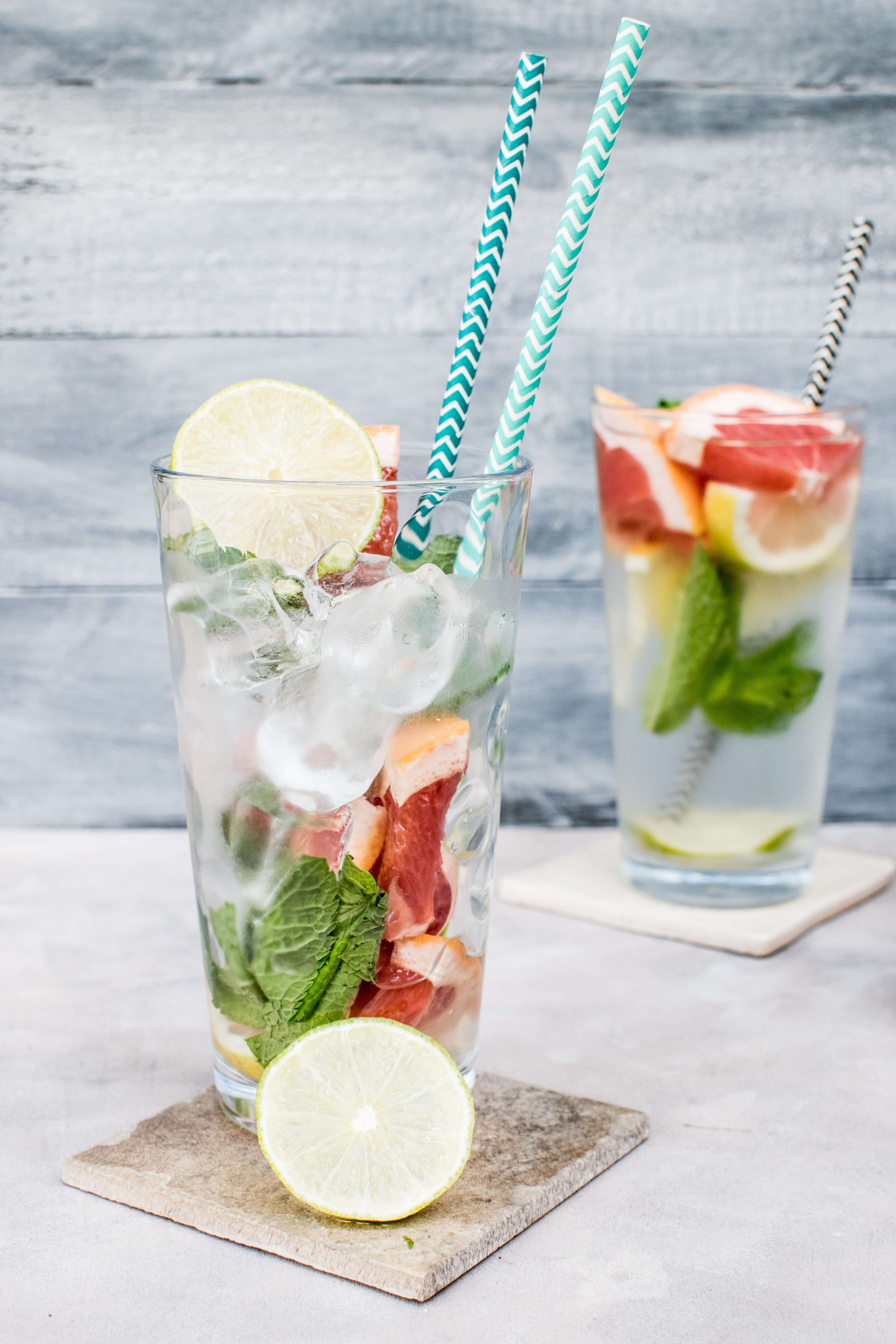
Who says cocktails have to be unhealthy? Not this RD.
Photo by: Monika Grabkowska
Want more information about the calorie counts of your favorite beverages? Check out one of my recent posts on this very topic!
Pump up the Veggies
Often at picnics there are more veggies available than one might think. Sometimes you just need to do a little searching. Crudite platters, tossed salads and even the infamous toppings for burgers are all good places to get those veggies in.
Are you trying to watch your carbs? Why not try a lettuce wrap instead of a bun? After all, if 5 Guys offers this option it has to be good, right? You can save yourself 200 calories and 30 grams of carbohydrates by this simple little swap.
Does the green salad look a little weak? Why not grab some of the ‘fixins’ for the burgers (think lettuce, tomato, onions) and ‘doctor’ up the salad (on your own plate, of course!) Or even better yet – offer to bring a kick-ass salad or some sort of veggie based side. Both options often require very little prep aside from assembly. This way you know you will have something to round your plate out aside from Grandma’s tuna mac salad 🙂
Don’t go Hungry
This rule holds fast for any type of celebration. Never. Ever. Ever. Go to an event hungry.
I repeat. Never. Ever. Ever. Go to an event hungry.
Most of my patients head to an event like a Memorial Day picnic with the mentality they are going to save all their calories for the day for one big meal. They plan to white- knuckle it the whole day until they get to the picnic. This backfires HARD pretty much every time. As soon as they see the food they everything short of bury their face in pretty much everything and anything that is out.
Instead plan accordingly. Have a light breakfast or snack prior to the picnic. Scrambled eggs and fruit, greek yogurt with 1-2 tablespoons of granola, an apple with peanut butter or something even as small as nuts or a cheese stick will keep your hunger at bay.
I much rather see you spend more time on the ‘front end’ in preparing than leave the picnic feeling big, bloated and polluted with an underlying sense of guilt. We all know this feeling! But YOU are stronger than this. Don’t allow yourself to be defeated. Instead plan ahead like the champ you are and leave the picnic with your rock-star status intact.
Keep it Lean and and No one will be Mean
Be a lean mean grilling machine at your next BBQ. After all, nobody goes to a BBQ saying, “I cannot wait to eat super sloppy BBQ food.” If you are the grillmaster instead choose lean cuts of protein to throw on the coals. Your guests will thank you!
Think 93 % lean ground beef, flank steak, grilled chicken breast marinated in a little balsamic, rosemary and oil, or even a veggie burger (just watch the sodium on those puppies some brands are crazy high!)
Truth bomb – many people opt for a turkey burger thinking it is the best choice. Best as we know is a relative term. Well, it’s not a horrible choice but is it the best choice? I am not so sure.

Did you know that beef burgers and turkey burgers often contain the SAME amount of calories and fat?
Did you know a turkey burger made from “LEAN” ground turkey has just about the same amount of calories and fat (150 – 170 calories & 7 -10 grams of fat for a 4 oz. patty) as a burger made from ground sirloin (93 % lean ground beef)? Lean ground turkey is generally a mix of light and dark meat. So if you are craving a nice juicy burger but are feeling guilty about eating red meat please don’t!
The only exception from a ground turkey standpoint is when the package states “EXTRA” lean. This type of ground turkey has virtually no fat, is expensive and in my humble opinion does not taste very good. It is certainly not good for burgers on the grill. With virtually no fat the burger will be unfortunately very dry.
Be a Good Friend
From my experience as someone who loves to host parties and tells everyone NOT to bring anything – never believe the host. They lie. I love it when someone brings something. SO be that good friend and come bearing food 🙂 This is your prime opportunity to bring something healthy that everyone (including yourself) will likely enjoy.
I can’t tell you how many times my patients say, “There was nothing healthy to eat so I had to eat crap.” Really? Come on my friend. No need to be so lazy! Get off your little butt and avoid all those excuses.
Remember it does not have to be something fancy, complicated or expensive. Heck stop at Costco and grab a veggie platter for $9.99 or a simple fruit bowl (also may I add for only $9.99 at Costco). Even a big old tub of hummus with a bag of baby carrots will likely be appreciated. Pick up a whole watermelon and bring that! After all, who doesn’t like juicy watermelon? The list of healthy options you can bring are seemingly endless.

Be a bestie and don’t forget to bring a healthy dish!
Want to step up your grame? Why not make a killer salad with everything but the kitchen sink in it? That way you can take whatever comes off the grill and and throw it on top of the salad. You will be surprised how many guests will follow suit. Because like I said, even though Memorial Day is typically synonymous with unhealthy foods, it does not have to be. More people than not are working hard to improve their health. Give people a handful of healthy options and they will thank you for it. A little effort goes a long way!
So whether or not it feels that way right now – Memorial Day will soon be here. While I am by no means asking you to be a saint (what fun would that be?) – why not start the summer season on a good foot? You have worked SO hard all winter. Let’s go into summer strong!
How do you anticipate to survive Memorial Day like a champ? What are your tried-and-true tips for a healthy summer holiday weekend? Leave your favorites in the comments below!
by Amy Plano | May 14, 2018 | General Nutrition, healthy dairy choices, healthy eating
Who the heck does not like yogurt ? After all the possibilities for its use are endless! It can be used as a base in parfaits, smoothies, soups, pancakes, and can even pinch-hit for sour cream. It is rich in protein and calcium and also contains potassium which is important for ♥ health. Yogurt also contains live, active bacteria cultures. These active bacteria cultures are also known as probiotics and are great for maintaining a healthy gut and digestive system. However, with so many choices choosing the best yogurt can be challenging to say the least!
Navigating the grocery store in search of can be tricky! Need some help grocery shopping? Check out my article on that very topic! I was in Shop Rite the other day and I kid you not – the yogurt aisle almost spans the entire length of the dairy aisle. I remember back in the day – the only two choices were Yoplait and Columbo . There were no flips, dips or cherry pie-flavored yogurts. Just the normal variety of boring flavors like vanilla, peach and strawberry.
Now a days there are SO many different options to choose from. Greek, traditional, flavored, plain, fruit filled, and varying percentages of fat are all factors to consider when buying yogurt. But what do these terms all mean? What is the best one in light of all these choices? Let’s get to the bottom of this madness asap!

What percentage fat yogurt should I buy?
This question is tough. In all honesty – it depends on your #dietarygoals are as well as your overall health.
If you have high cholesterol or are just trying to keep your calories on the low side then choose either a low-fat (1%) or fat-free (0%) variety. These two choices generally have the lowest calorie value and contain a nominal amount of saturated fat. Look for labels that have the lowest amount of saturated fat.
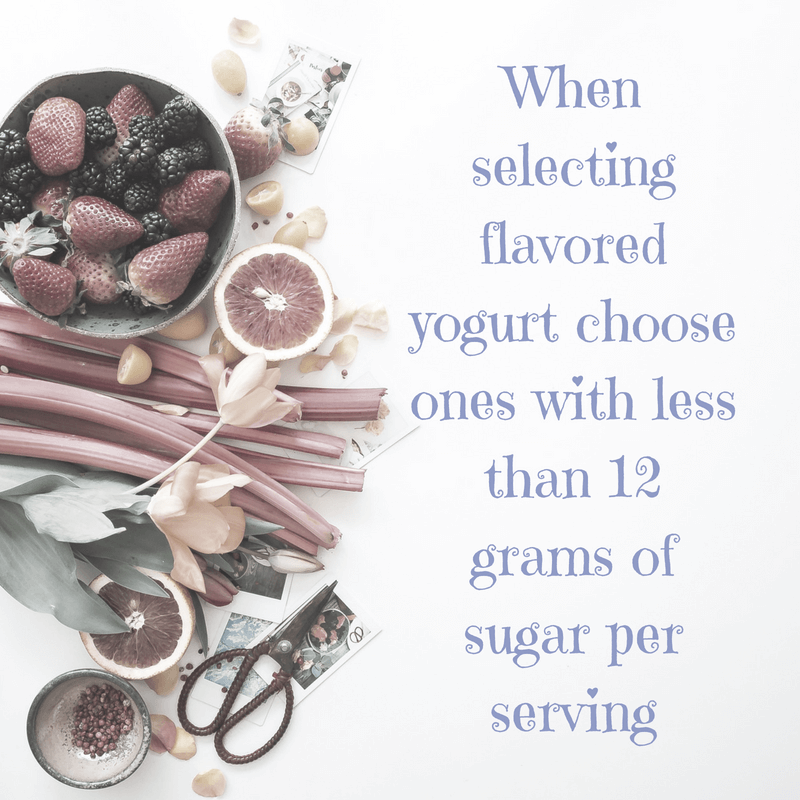
However, if your cholesterol is not an issue and you are just looking for a yogurt with a thicker consistency then opt for a 2 % or full-fat kind.
I personally prefer 2% or full-fat plain yogurt. My favorite traditional brands when I can find them (please don’t laugh 🙂 ) are YoBaby Whole Milk Plain Yogurt or Liberte Plain 2 % Yogurt. Shop Rite generally carries the YoBaby. But lately I can only find the plain Liberte yogurt at Whole Foods. The reason why I like these brands is # 1 (and most important) they taste pretty darn good ! And # 2 both brands contain under 10 grams of sugar. Also they have no added funky ingredients.
Which is best: Greek or traditional ?
Greek yogurt is strained which makes it thicker, creamier, and smoother than traditional kind. When comparing Greek and traditional yogurt, Greek has around double the protein but does have less calcium than traditional kind. Both the Greek and traditional varieties are usually well tolerated by individuals with lactose intolerance. However, the Greek type has less lactose (than traditional) and may be better tolerated than traditional yogurt. Most people prefer Greek to traditional yogurt because of the higher protein content.
Nowadays pretty much every major brand has both a traditional and a Greek yogurt. Even Chobani who started out their career just selling Greek now has a “old-fashioned non-Greek traditional smooth yogurt”. Therefore, you can be brand loyal and still get your pick of the litter!
However, please don’t fret if you just don’t love Greek yogurt! Many of my patients don’t like it and prefer the traditional style instead. Keep in mind – the average American consumes more than their daily requirement for protein. So if you opt for the non-Greek variety you will not be selling yourself short in meeting your protein needs.
Favorite Greek yogurt brands
For the Greek yogurts I personally bounce around brand wise depending upon what is on sale and has the lowest amount of sugar per serving. I shop mostly at Trader Joe’s. But unfortunately (aside from their ‘plain’ Greek) they do not carry a whole bunch of options under 10 – 12 grams of sugar. Some of the Greek style brands in my fridge now are Siggi’s Greek – 2 % Black Cherry, Fage Yogurt-2% plain, and Chobani Plain Whole-Milk Greek Yogurt.
Should I buy plain, flavored, or fruit filled yogurt?
One of the major issues with yogurt is it often has added sugars. It is made from milk (duh!) and therefore has naturally occurring sugar in it, called lactose. Thus, if you look at the nutrition label of plain yogurt, you will notice it has 12 g of carbohydrates. Since this sugar is naturally occurring, it is not of concern. However, what is concerning is the large amount of added sugars in many yogurts. A serving of flavored yogurt can contain an upward of 30 grams of sugar depending on the brand. That is a wholelata sugar! A can of soda has about 24 grams of sugar so the comparison is clear.
How to dodge the sugar
You can skip the added sugars by buying plain yogurt. Then you can be creative and add your own fruit and flavors such as cinnamon and vanilla. Hello fancy pants! You can even go nuts with different extracts such as almond, coconut or coconut to pump up the flavors without the calories or carbs.
When you buy the flavored variety, check the nutrition label and try to buy a containing less than 12 grams of sugar per serving. Some of the brands with the lowest amount of sugars including Dannon Oikos Triple Zero, Chobani Hints, and Siggi’s Greek mentioned above.

Trying to decrease your overall sugar intake? Choose plain yogurt and add your own fresh fruit #squadgoals
Navigating the yogurt aisle used to be challenging! But now, you should be able to navigate the dairy aisle with ease. Opt for low sugar yogurts that fit your dietary goals, budget and taste palate. Selecting an appropriate yogurt should now be pretty easy!
As always, if you have a question bring the nutrition label to your nutrition visit and the dietitian can review it.
What is your absolute favorite one on the market? Tell us what you think in the comments below.
by Amy Plano | Jan 16, 2018 | General Nutrition, weight loss, weight loss and alcohol
Alcohol 101: How can alcohol fit into my diet?
One of the common questions I receive in my practice is, how can alcohol fit into my diet? Honestly, as an RD I have nothing against alcohol. In fact, if you were to review many of my customized meal plans you would see I actually purposely put alcohol on my patient’s meal plans. While, I personally can count on one hand how many drinks I have in the course of a year it does not by any means make me a hater. Honestly, it seems like I did SOOOO much drinking before I turned 21 (many, many, many moons ago!) that when I finally did actually reach the legal drinking age – I was all set 🙂 SO I will cheer YOU on!
However, as we all know calories in drinks can add up fast. And as a result, instead of seeing results, patients remain “stuck” in a weight loss plateau. Sound familiar?

Since alcohol is a pretty much part of just about every social occasions including family parties and nights out with friends seems like it would be worth chatting about. Right? Whether you are trying to lose weight or build muscle, drinking alcohol too frequently can get in the away of your goals (shocker right?!). However, this does not mean you have to give up the occasional drink or night out with friends. Rather, just do so in moderation. And follow my tips for making the best choices when it comes to alcohol. Winner, winner, winner chicken dinner!
What is a standard drink?
First things first. Before we talk about how alcohol can fit into your diet we probably need to define an alcoholic drink. Most people are surprised to learn what counts as a standard drink. The amount of liquid in your glass doesn’t always match up to the alcohol content of your drink. Different types of beer, wine, and hard liquor can have different percentages of alcohol content.
In the U.S., a standard drink contains roughly 0.6 fluid ounces or 14 grams of pure alcohol.
One standard drink includes:
12 ounces of beer with 5% alcohol content
5 ounces of wine with 12% alcohol content
1.5 ounces or a shot of 80-proof distilled spirits of liquor with 40% alcohol content
What has more calories: beer, distilled spirits, or wine?
The calories per each standard drink are as follows:
• 1.5 ounce drink of distilled spirits (40 % alcohol) is 98 calories, 0 g CHO, 0 g Pro, and 0 g Fat.
• 12 ounce drink of regular beer (5 % alcohol) is about 150 calories, 13 g CHO, 2 g Pro, 0 g Fat.
• 5 ounce drink of wine (12 % alcohol) is about 120 calories, 4 g CHO, 0 g Pro, 0 g Fat.
What are the current recommendations for alcohol?
The Dietary Guidelines for Americans alcohol recommendations differ for men and women. Women are encouraged to limit alcohol to up to 1 drink per day. While men have a slightly longer leash of up to 2 drinks per day. The Dietary Guidelines do not recommend that individuals who do not drink alcohol start drinking for any reason. Translation – there is no nutritional value to drinking. Therefore, no need to establish a “new” habit if you don’t already have one.

Aint’ that the truth ?!?
The Dietary Guidelines also warn about the side effects of excessive drinking. These include: binge drinking, heavy drinking, and any drinking by pregnant women or people under the age of 21. Binge drinking is defined as drinking more than 4 drinks during a single occasion for women and more than 5 drinks during a single occasion for men. Heavy drinking is defined as consuming 8 or more drinks per week for women and 15 or more drinks per week for men. If you are confused, please see above to see what counts as a standard drink.
Consequently, excessive alcohol use can lead to the development of chronic diseases and other serious problems. These may include hypertension, heart disease and stroke. Not to mention liver disease, digestive problems, cancer, learning and memory problems, mental health problems, social problems, and alcoholism. And how about them calories?
What does my drink ‘cost’ me?
I have done my best to establish a list of what I would consider commonly consumed alcoholic drinks. As mentioned previously, the calorie counts mentioned above are just for the alcohol. They do not address the multitude of beverages alcohol can be mixed with. My list below does include the mixers. The list is comprehensive but by no means all inclusive. Furthermore, don’t quote me on all the values – they are more or less estimates and refer to a standard drink. Depending upon who is making your drink – they may pour more or less alcohol and/or add more or less juice/soda/tonic/mix.
If you do not find your drink of choice on this list, you can check out Calorie King for additional nutrition information.

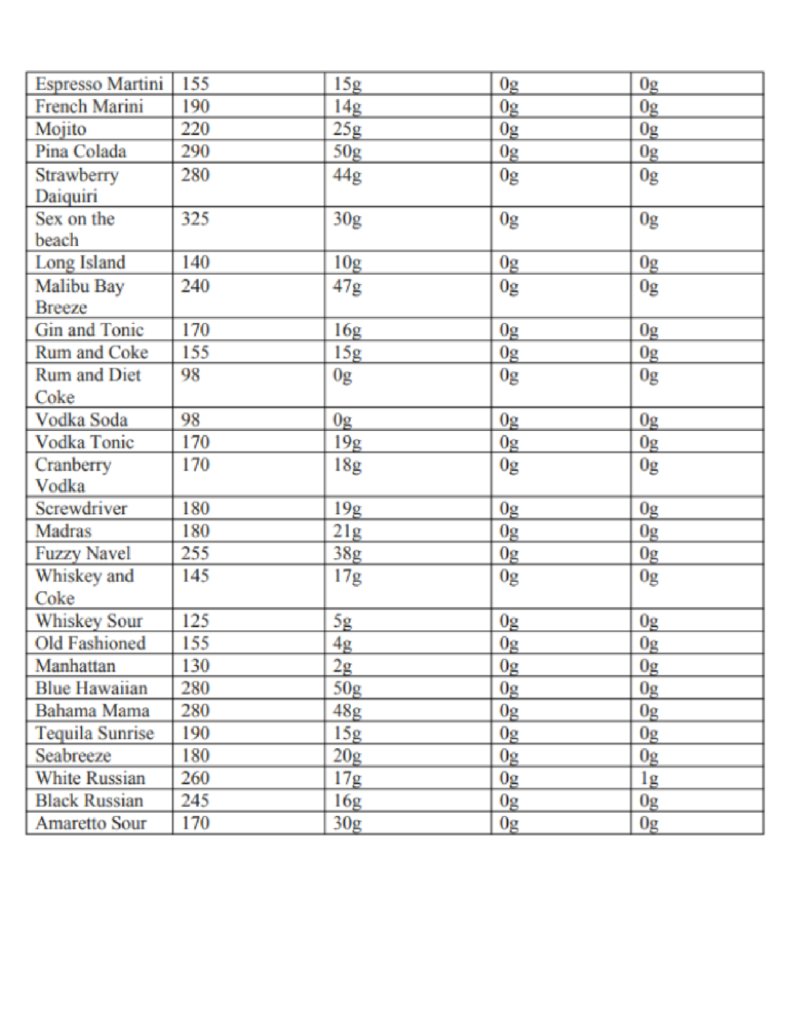
Now that you know the numbers – let’s get down to the basics.
Be mindful of the mixers
The addition of juices, sodas, and sugary syrups are a caloric and sugar force to be reckoned with. And just because your drink is “clear” does not by any means it is free of calories. There’s a common misconception that tonic water is the same as seltzer water, but it actually contains a lot of calories and sugar. Or some folks think because their drink is mixed with juice – it is a better choice. Most juices contain at least 110 calories and 25 grams of sugar per 8 ounce serving. So you add in a shot of alcohol and you are looking at + 220 calorie plus drink. While this may seem somewhat benign when you are on a calorie budget every calorie counts.
Instead try herb infusions, flavored club soda, or a squeeze of citrus. And if you choose so, use diet soda instead of sodas laden with sugar. Below are examples of low calorie mixers.
* Diet soda or diet tonic: 0 calories
* Light orange juice (8 oz): 50 calories
*Diet cranberry juice (8 oz): 5 calories
*Light cranberry juice (8 oz): 40 calories
*Light lemonade (8 oz): 5 calories
*Baja Bob’s sugar-free margarita or sweet ‘n’ sour mix: 0 calories
*Lemon or lime juice (1/2 oz): 10 calories
*DaVinci or Torani’s sugar-free syrups: 0
Keep it Simple
Or you can even skip the mixer altogether. Try ordering your favorite spirit or one of the new flavored liquors on the rocks (translation just on ice). Infused and ‘flavored’ vodkas are very popular because they are not sweetened but infused with flavor. There are a whole host of flavors ranging from jalapeno to peach to blueberry, to lechee fruit. You name it – there is probably an infused liquor with your favorite flavor. And best of all the flavor exists without adding any extra calories. The alcohol itself has calories (9 calories/gram) but you are saving on the calories from the mixer without compromising taste.
One of my favorite things to do (for the handful of drinks I have per year) is to make my own infused tequila. I take a whole pineapple and slice it into small disks. Next, I take about 4-5 jalapenos – seeds and all and chop them up. I then put the sliced pineapple and peppers into a tall glass pitcher. Next, I pour 2-3 cups of tequila over the fruit and peppers. I cover the mixture let it sit for about 4-5 days. Each day I muddle the mixture with a wooden spoon to release the juices and oils. Once the mixture is good and spicy I strain the liquid through a fine sieve and throw out the fruit and peppers. Lastly, I refrigerate the tequila until I am ready to use it for spicy margaritas! Yum!
Settle for a “spritzer”
Sounds pretty fancy, right? If you just want to be social and club soda won’t cut it with the company you’re keeping, ask for a wine spritzer, heavy on the spritz. All this is wine mixed with club soda. If you want to get extra fancy you can even try some of the zero calorie flavored seltzers to pump up the flavor.
Hydrate healthfully
You knew this was coming. Alcohol is a diuretic. Replacing fluid, particularly in warmer climates (hello Caribbean vaca), is essential. Calories (and sugar!) aside, try to make every other drink either club soda, sparkling water, or just plain water. Adding ice cubes to your beverage will help hydrate you and also make your glass of booze feel bigger.
Volunteer to be the DD
The best way to prevent alcohol from derailing your diet is to avoid drinking altogether. Why not volunteer to be the DD (designated driver) and save your group taxi or Uber costs by offering to drive? While it may not be as fun as indulging with your group, you’re the one who’ll wake up the next day without a food or alcohol hangover. And as we all know that feels pretty dang good.
Conclusion
Bottom line – If you budget your calories carefully, you can safely “afford” to have a drink or two on a special occasion. But drinker be ware. Drinking loosens your inhibitions and may prompt unconscious eating. Additionally, drinking alcohol can also make you feel hungrier because alcohol can lower your blood sugar. SO why not grab a quick bite before you imbibe? Some good pre-party noshes: a small meal or snack containing fiber, protein and healthy fat. These might include a low-sodium chicken soup, greek yogurt and fruit, low-fat cheese and whole-wheat crackers, or a handful of nuts.Therefore, from a health standpoint, calories aren’t the only thing to consider. Practice moderation and always, always, always have a designated driver. Heck call me – and I will come get you!

by Amy Plano | Jan 8, 2018 | weight loss

Often when I am counseling my patients I feel like a broken record. It seems like I am constantly catch myself making the same basic recommendations over and over. Don’t get me wrong — these suggestions are important! However, I thought would not it be great if I just came up with a summary of all these super-duper awesome recommendations and compiled them in a list for my patients. And smarty pants Plano did just that. Therefore, below are some of what I consider my top tips for weight loss. The goal is in future blogs to elaborate on each of the topics. I plan to go into the details of just why they really are so freakin’ important.
Amy’s Tips for Weight loss
Want great results? Weigh and measure your food for at least 14 days. You can find inexpensive food scales (I am talking under 10 bucks!), measuring cups and measuring spoons at Target, Walmart and Amazon.The scale does not need to be fancy! It just need to get the job done!
Want the BEST results? Track your food. Religiously like it is your job. You can use any program you want (MyFitness Pal, Sparkpeople, Lose It – heck even just a cute little notebook) as long as you log every morsel (extra spoonful of peanut butter I am talking to you!) you put into that pretty little mouth of yours. And I do mean EVERYTHING!

What gets measured get managed.
You can consume unlimited amounts of veggies. The only veggies that are not unlimited are peas, corn, potatoes and butternut squash. Most of all – NO need to weigh your veggies.
If you purchase canned products such as tuna, chicken or vegetables please give them a good rinse by running them under cold water to remove the excess salt.
Season away! You don’t have to eat your food plain. Please feel free to ‘doctor’ it up with spices, herbs, flavored vinegars and low-sodium stocks.
Be mindful of any sauce (BBQ, teriyaki, soy sauce, ketchup) as many have significant amounts sugar, sodium and sugar.
Always do your best to purchase reduced sodium and/or low sodium deli meats. While they are often more expensive – they are MUCH lower in salt and better for your overall health.
Drink Up! Drink half your weight in ounces. For example if you weigh 200 pounds you want to shoot for about 100 ounces per day. Cheers!

Make it pretty. It will taste better!
If you can afford it – always try to purchase Cage Free Organic Eggs. They are free of hormones and high in Omega 3’s which are a heart healthy fat.


Got Caffeine? Do your best to limit what you put in your coffee. Sugar, honey, agave, cream and milk all add extra calories and carbohydrates.
Try like heck to get in your 10,000 steps per day!
I hope you find these tips for weight loss helpful!
by Amy Plano | Nov 13, 2017 | General Nutrition
Healthy Baking Substitutions to Lighten Up Your Holiday Treats
I seriously cannot believe it is November! Can you?! Next week is Thanksgiving (my favorite holiday, of course!) and before you know it Christmas will soon be here. Now is the time of year for holiday parties and celebrations with family and friends. This also means it is the time of year for delicious and tempting desserts.

Oh my! But, the good news about this year is I have some tips for making your traditional dessert recipes healthier. Check out my healthy baking substitutions and you can enjoy that cookie, cake, or brownie without so much guilt.
Substitutes for flour:
Black beans. Using black beans instead of flour can add protein with the same great taste. This is particularly tasty when baking brownies. When baking, swap out 1 cup of flour for 1 cup of black bean puree.
Whole wheat flour for white flour. Using whole wheat flour instead of white flour, adds fiber, which helps with digestion. Use 7/8 cup of whole-wheat flour for every cup of white flour.

Substitutes for sugar:
Unsweetened applesauce. Applesauce provides the same sweetness without the extra calories and sugar. You can substitute applesauce with sugar in a 1:1 ratio. However, you should reduce the amount of liquid in the recipe by ¼ cup.
Vanilla extract. Adding vanilla extract and cutting the amount of sugar down can give great flavor without extra calories. You can try cutting 2 tablespoons of sugar out of your recipe and adding an extra ½ teaspoon of vanilla extract.
Stevia. Stevia is a natural sweetener that is lower in calories, but also much sweeter than sugar. Since stevia is sweeter, a recipe calling for 1 cup of sugar should only be swapped for 1 teaspoon of liquid stevia or 2 tablespoons of stevia powder.
Substitutes for oil or butter:
Unsweetened applesauce. Applesauce gives the same consistency without the fat. It works well in breads and muffins. Substitute half of the fat in your recipe with applesauce.
Avocado puree. Avocado provides creaminess with a healthy addition of unsaturated fats. This tends to be better in brownies and chocolate desserts. Using 1 cup of avocado puree per cup of butter works.
Mashed bananas. Bananas add a good consistency with added nutrients like potassium, fiber, and vitamin B6. One cup of mashed banana works perfectly in place of 1 cup or butter or oil.

Prunes. Prunes can make a great substitute for butter and cut the calories and fat down. Combine 3/4 cup prunes with 1/4 cup boiling water, and puree to combine. Sub in equal amounts in most dark baked good recipes.
Greek yogurt. Substitute for Greek yogurt for oil. This can help cut fat and calories without a difference in taste. Substitute 1 cup of oil for ¾ cup of Greek yogurt.
Substitute for cream:
Evaporated skim milk. It provides the same consistency with less fat. Use 1 cup of evaporated skim milk for 1 cup of cream.
Please make sure you try these healthy baking substitutions prior to serving a recipe to others. Healthy can make a great difference, but it takes practice to master them. Making recipes healthier is worth the extra effort!
Hugs & High Fives,

































